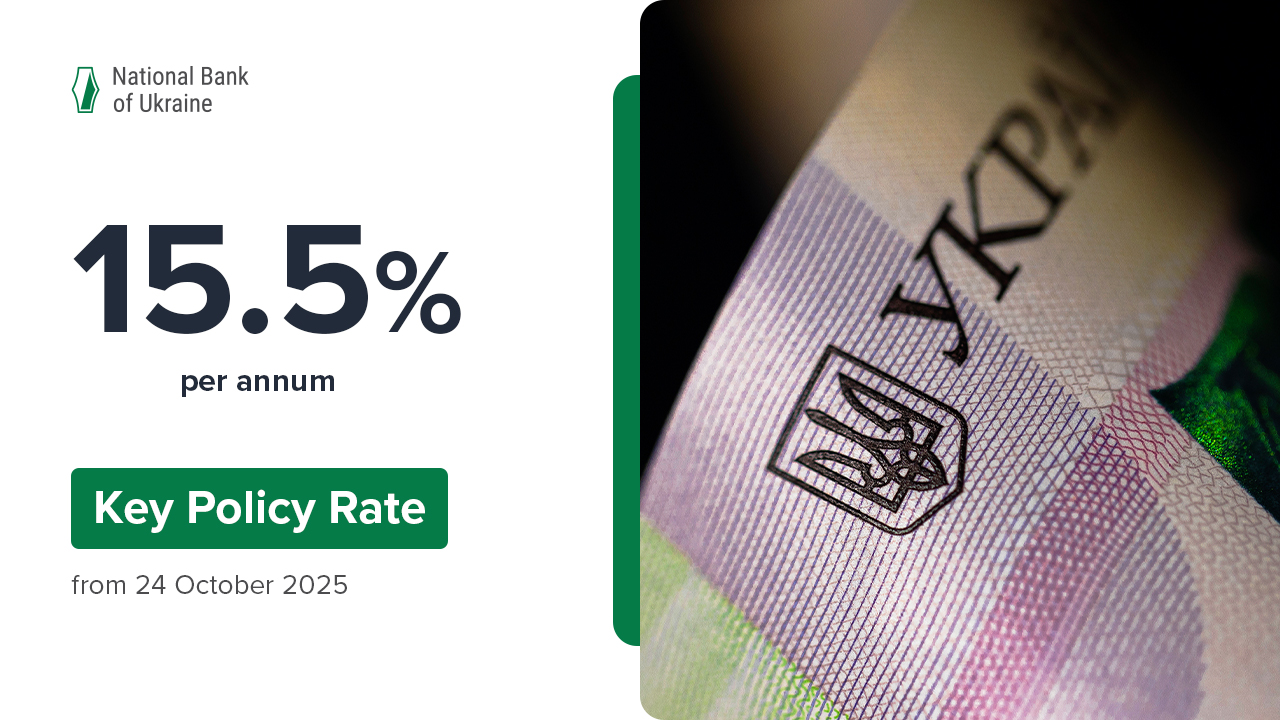Dear colleagues!
I am delighted to welcome you to the presentation of the first issue of the National Bank of Ukraine’s Financial Stability Report.
The NBU’s primary objective to ensure both price and financial stability. The leading central banks and global financial markets regulators focused their efforts on performing this function following the global financial crisis of 2008-2009 and the debt crisis in the euro area. The NBU keeps pace with best practices applied by the world's central banks and regulators.
In July 2015, we succeeded in amending the Law of Ukraine On the National Bank of Ukraine. Since then, our mandate has been expanded to include promoting financial stability, in particular the banking system's stability. Last spring the Interagency Financial Stability Council and the NBU’s Financial Stability Committee were established to serve as platforms to coordinate decision-making process in this area.
The Financial Stability Report plays a key role in ensuring the central banks’ ability to perform this function. Along with the Inflation Report, this Report is a key public document produced by central banks across the world. The Financial Stability Report was first released by the Bank of England 20 years ago. Nowadays these reports are published in more than 80 countries across the world. Furthermore, the International Monetary Fund publishes the Global Financial Stability Report twice a year, while the Bank for International Settlements produces quarterly reports on global financial markets and capital flows.
The Financial Stability Report, to be published twice a year, analyzes risks to financial stability, provides insight into economic and banking sector developments, and assesses their potential impact on the current situation in the country. This analysis is at the core of the NBU’s policy aimed at ensuring financial stability. This analysis is at the core of the NBU’s policy aimed at ensuring financial stability.
Furthermore, this paper provides financial market participants, primarily banks, with a tool to better assess the market situation and avoid assuming unpredictable risks. The Financial Stability Report also offers recommendations to financial institutions and government authorities on actions and measures, which, in our view, are critical for enhancing financial stability and mitigating risks.
What conclusions have we arrived at?
First and foremost is that Ukraine has overcome the most difficult phase of the crisis, yet the Ukrainian financial system remains extremely vulnerable external shocks and internal risks.
Over the past two years, Ukraine's economy and banking sector have gone through the deepest crisis in the history of independent Ukraine. However, certain downside risks to financial stability remain.
Macroeconomic stability is gradually taking hold. Both the NBU and independent experts expect Ukraine's economy to return to growth this year. Headline remained in the single digit territory for the second month in a row after soaring to above 60% a year ago. In May, inflation moderated to 7.5% y-o-y and to 5.2% YTD (year-to-date). In monthly terms, inflation eased to 0.1% m-o-m.
Already last year, financial risks alleviated substantially. Thanks to the cooperation with the International Monetary Fund and the stabilization of the FX market, Ukraine’s international reserves have increased by 80% since the beginning of 2015 to USD 13.5 billion. The resumption of cooperation with the IMF will enable Ukraine to continue building up international reserves.
Furthermore, the stabilization of the money and FX markets, enabled the National Bank of Ukraine to push ahead with its plans to gradually phase-out administrative restrictions put in place over the past two years. We stepped up our efforts to remove restrictions in the spring of 2016 and keep moving in this direction as fast as possible without destabilizing the situation. Yesterday alone we took a series of important measures, which would help improve the business climate, while preserving financial stability.
- We have eased surrender requirements for foreign exchange proceeds from exports from 75% to 65%, effective from today. The Ukrainian exporters are likely to benefit from the move.
- Also, the maximum amount of FX cash and banking metals that banks are allowed to sell to an individual per day has been increased from an equivalent of UAH 6,000 to UAH 12,000.
- We have streamlined the rules governing currency exchange operations by lifting the requirement for bank cashiers to make copies of the relevant pages of the ID document if the amount of foreign currency sold by a bank to an individual does not exceed the equivalent of UAH 150,000.
- The NBU has also increased the amount of FX cash or banking metals that could be withdrawn from clients’ accounts per day from UAH 50,000 to UAH 100,000. This NBU has lifted restrictions on hryvnia cash withdrawals (individuals are currently allowed to withdraw UAH 500,000 per day) from clients’ accounts. This move should further contribute to the restoration of confidence in the banking sector and encourage inflows of deposits in domestic and foreign currency into banks.
- Finally, the most important measure taken by the NBU to improve the investment climate was to give foreign investors the green light to repatriate dividends accrued over the past two years. This move was announced by the regulator earlier this year.
The NBU is set to move ahead with its plans to liberalize FX controls in a gradual manner if the money market and FX market conditions, as well as the economic situation are favorable.
Further alleviation of risks to macroeconomic stability has helped to get the banking sector “back to normal”. Confidence in the domestic banking sector is gradually restored – household deposits in domestic currency registered an rise of 31% since Q2 2015, with foreign-currency deposits increasing by 3.5% since December 2015. We expect household deposits to remain on an upward trend in 2016, with the banks' deposit base expanding by as much as 10% in 2016.
Nevertheless, we are fully aware of the fact that the domestic economy and the banking system remain vulnerable to external shocks, while risks remain high. The recovery of bank lending is still hampered by the heavy debt burden of enterprises, poor solvency of most economic sectors and heightened judicial risks.
It should be noted that we have made significant progress in getting the economy back on track and our contingency measures have proved successful. However, there is still a long way to go. The NBU, banks and all the public authorities are faced with numerous tasks.
As you may know, the NBU has conducted the most comprehensive and detailed diagnostic studies of the top 20 banks in its history. The diagnostic package comprised Asset Quality Review and Stress-tests, analysis carried out to test banks' capacity to withstand economic shocks. According to the results of the diagnostic studies, 16 out of the top 20 banks required additional capital. This year the NBU is undertaking diagnostic studies of the next 40 banks. Thus, we will have a detailed picture of the quality of assets held by 60 banks accounting for 97% of the banking sector.
The results of the stress tests on the largest banks are an integral part and a key input to analysis of systemic financial stability risks. Therefore, we plan to conduct regular stress-test exercises to examine banks' resilience to credit, market and operational risks. Going forward, we are going to use them as a standard instrument to assess the financial resilience of individual banks and the banking system as a whole. This approach is in line with international best practices.
However, we are going to move further in this direction.
Over the coming months, the NBU faces a series of important tasks aimed at mitigating the exposure of the financial and banking system to risks.
First, we plan to streamline approaches to credit risk management. Most notably, we seek to change the rules to prevent the accumulation of systemic risks in the future. We will have approved a new regulation on credit risk assessment by the end of the month.
Second, we intend to develop and approve a roadmap for the harmonization of domestic banking laws and regulations with Basel committee recommendations and EU directives. We understand that it is a difficult and long process requiring more efforts.
At the same time, the success in ensuring financial stability hinges on decisions taken by the management of financial institutions. In our view, banks should channel their efforts towards performing a number of key tasks.
First, we recommend that banks review and enhance internal risk management frameworks. Banks should focus their efforts on improving the quality of assets, particularly the quality of loan portfolio rather than on competing for the market share. Going forward, the NBU experts should set out the rules to be followed by market participants and ensure the banks’ compliance with these rules rather than do the job that should be done by banks' risk managers.
Second, banks should adjust their own business models to the new conditions. Banks that are unable to generate operational profits should take bold and prompt measures to restructure their business and cut operating expenses substantially. The regulator monitors and assesses banks’ business models to make sure that banks operating domestically are viable.
Third, banks are strongly advised to implement in full recapitalization plans and restructuring programs developed based on the findings of diagnostic studies.We monitor the progress made in the implementation of these programs. The NBU has taken an uncompromising stance on this issue. We welcome the significant progress made by the banking sector: 16 banks of the top 20 banks that required additional capital have already implemented a three-year program ahead of schedule. However, two banks have been put into resolution either due to the shareholders’ unwillingness or inability to implement the plans submitted to the NBU.
We also keep monitoring closely the progress made by banks in implementing the programs aimed at unwinding related party lending. As we have already stressed, it is unacceptable to use household deposits to finance the bank shareholders’ business. Related party lending will become history within the next few years.
Of course, no improvements can be attained without efforts to upgrade the legislation. Therefore, I would like to use this opportunity to once again voice concerns raised by the NBU and the banking community in this regard.
Draft laws intended to encourage banks to ramp up lending are still pending in parliament. These include draft laws on voluntary financial restructuring, on foreign exchange mortgage lending, as well as draft laws intended to enhance the protection of creditor rights. If passed, these laws will enable banks minimize losses and the NBU to complete the process of resetting the financial system.
Another important issue is the launch of the reform targeting state-owned banks. Over a long period of time, these banks have remained inefficient due to poor corporate governance, lack of clear business models, and lending to enterprises controlled by politicians. These practices pose substantial fiscal risks. Over the past nine years, almost UAH 90 billion has been injected into the state-owned banks that required additional capital. Therefore, these banks should review corporate governance standards and practices within the shortest time possible.
It is necessary to encourage strategic investors to participate in the equity of state-owned banks. These banks should operate based on the principle maximizing return on equity. The NBU fully supports the principles underlying the reforming of state-owned banks set out in the Strategy for reforming public banks.
We strongly recommend that this program be launched as soon as possible. It is necessary to start with changing the principles governing the formation of Supervisory Boards at the state-owned banks and the appointment of managers through a competitive selection process. To this end, it is necessary to amend some Ukrainian laws. I would, therefore, like to once again call on parliament to back these amendments.
I would also like to bring to your attention the fact that the NBU has embarked on efforts to develop a framework for macroprudential regulation.
The recent financial crisis has shown that efficient monetary policy and macroprudential supervision might turn out to be insufficient to prevent the accumulation of systemic risks in the financial sector. Unlike microprudential policy (or banking supervision), macroprudential policy aims at identification and estimation of systemic risks to financial stability at the level of the financial system as a whole.
Going forward, the NBU also intends to deploy macroprudential policy instruments that will compliment monetary policy instruments. The publication of the Financial Stability Report represents the first step in this direction.
Thank you for your attention!






